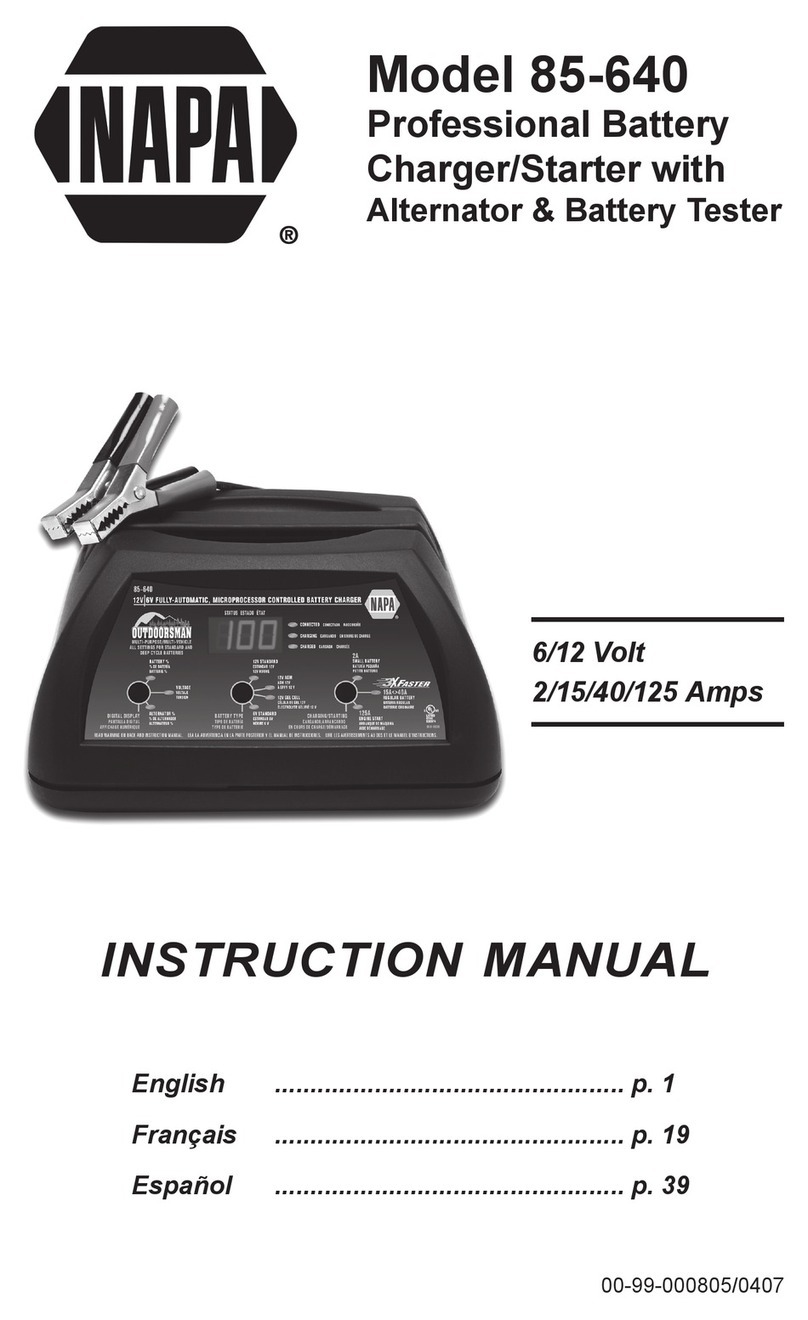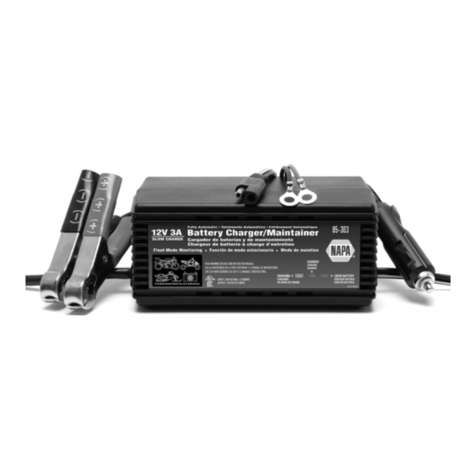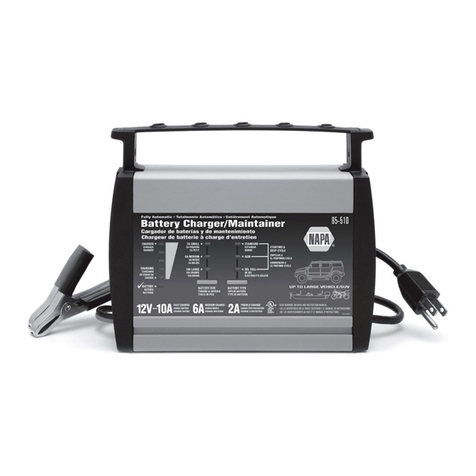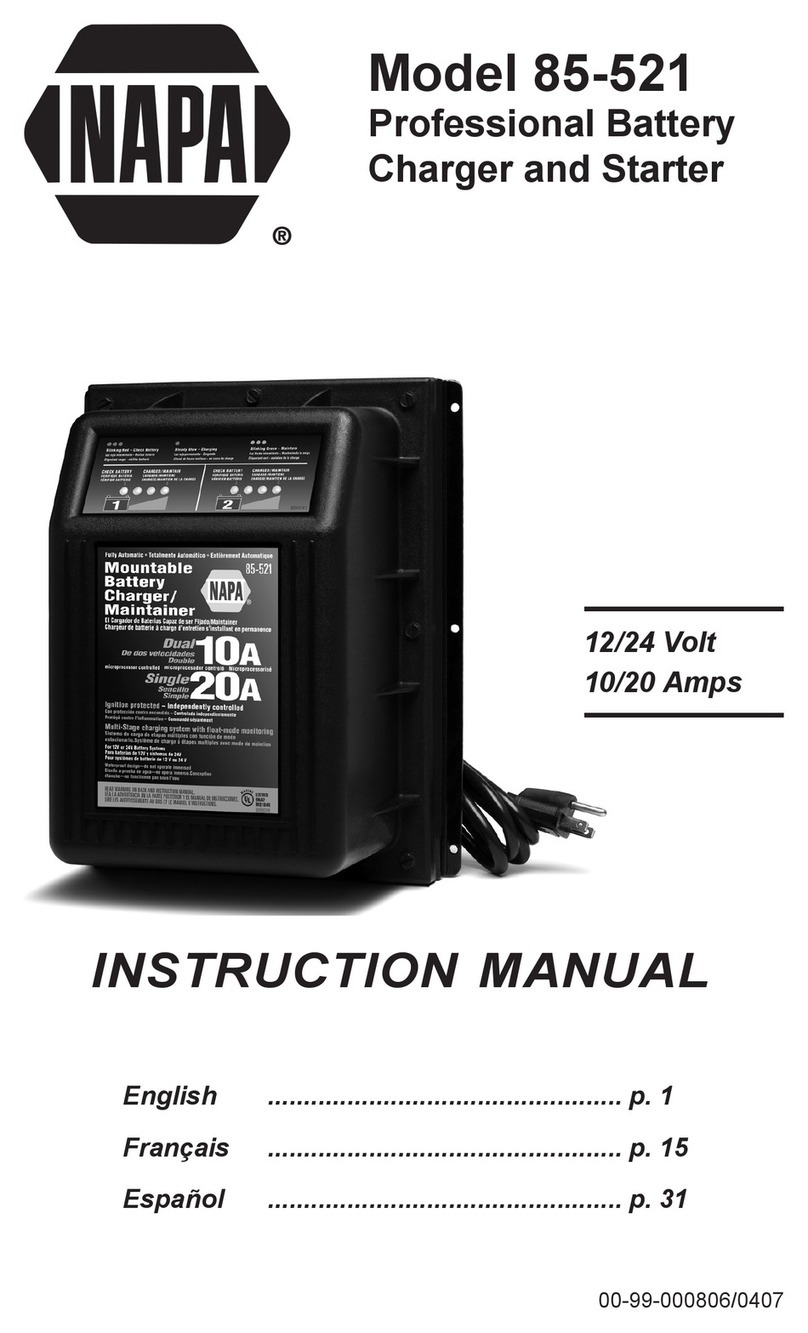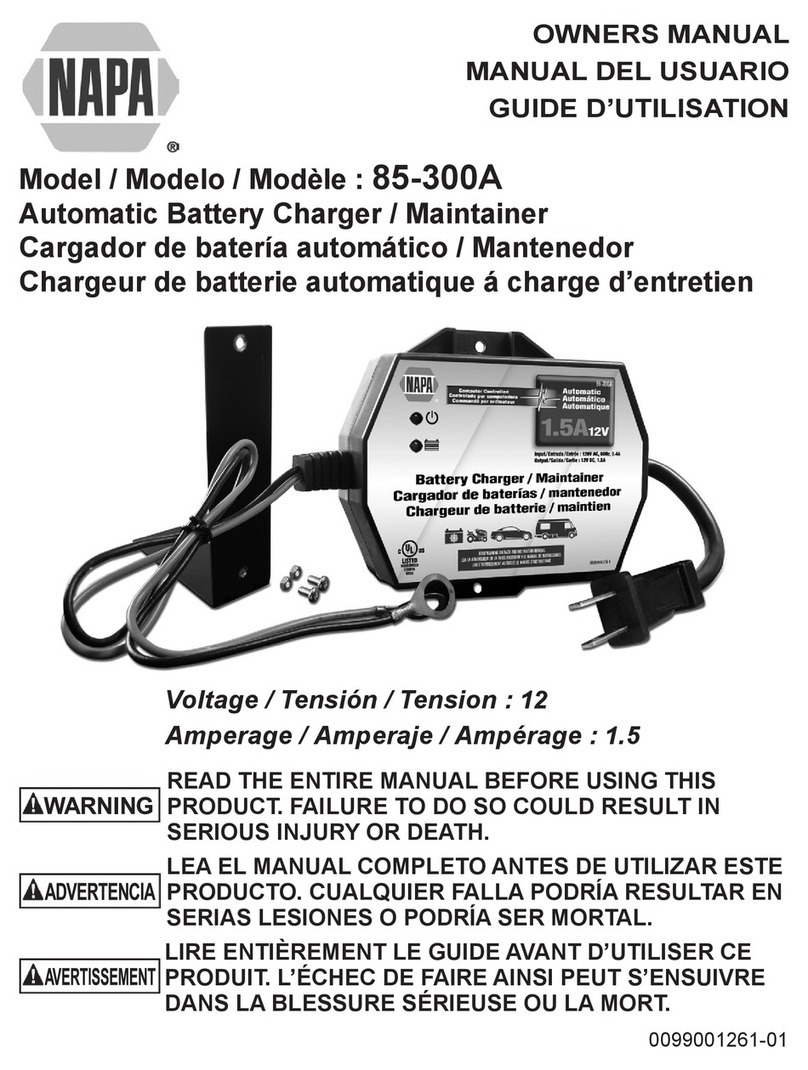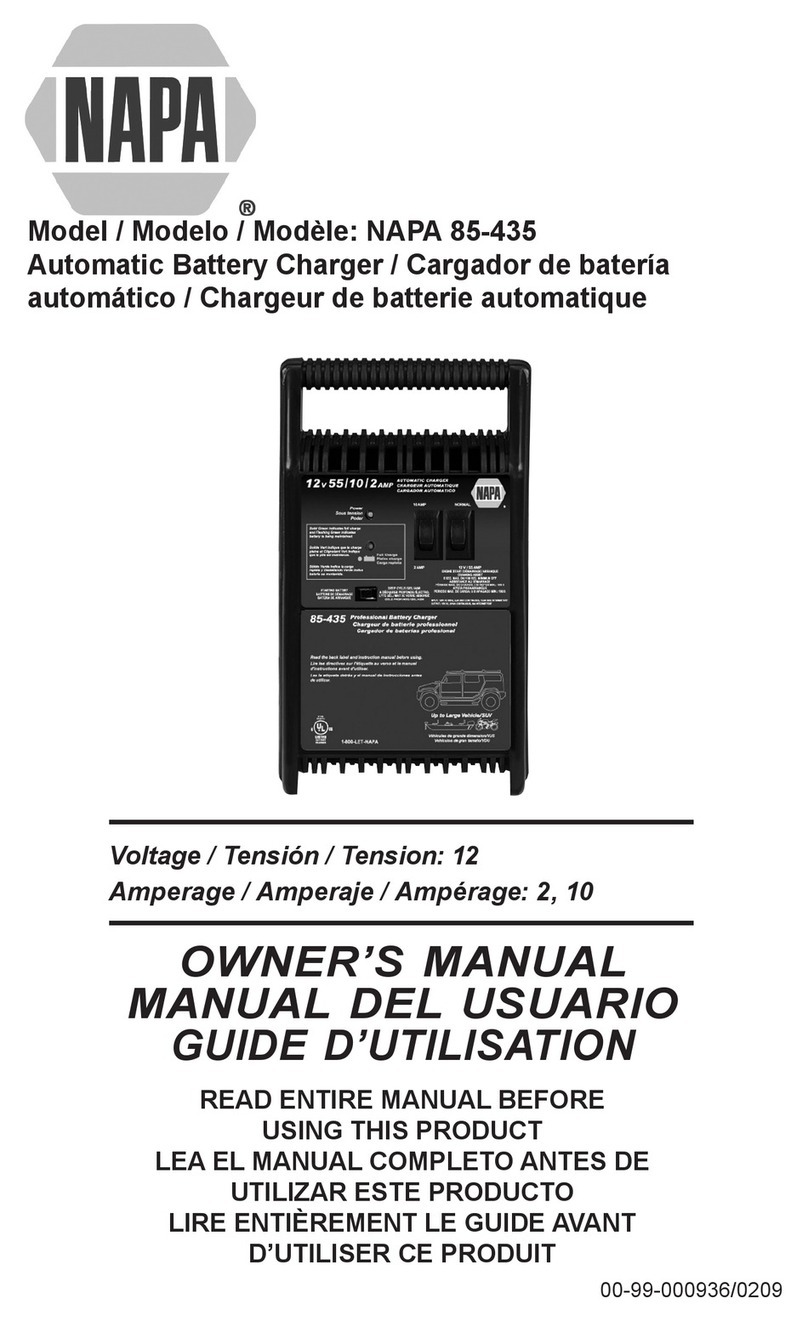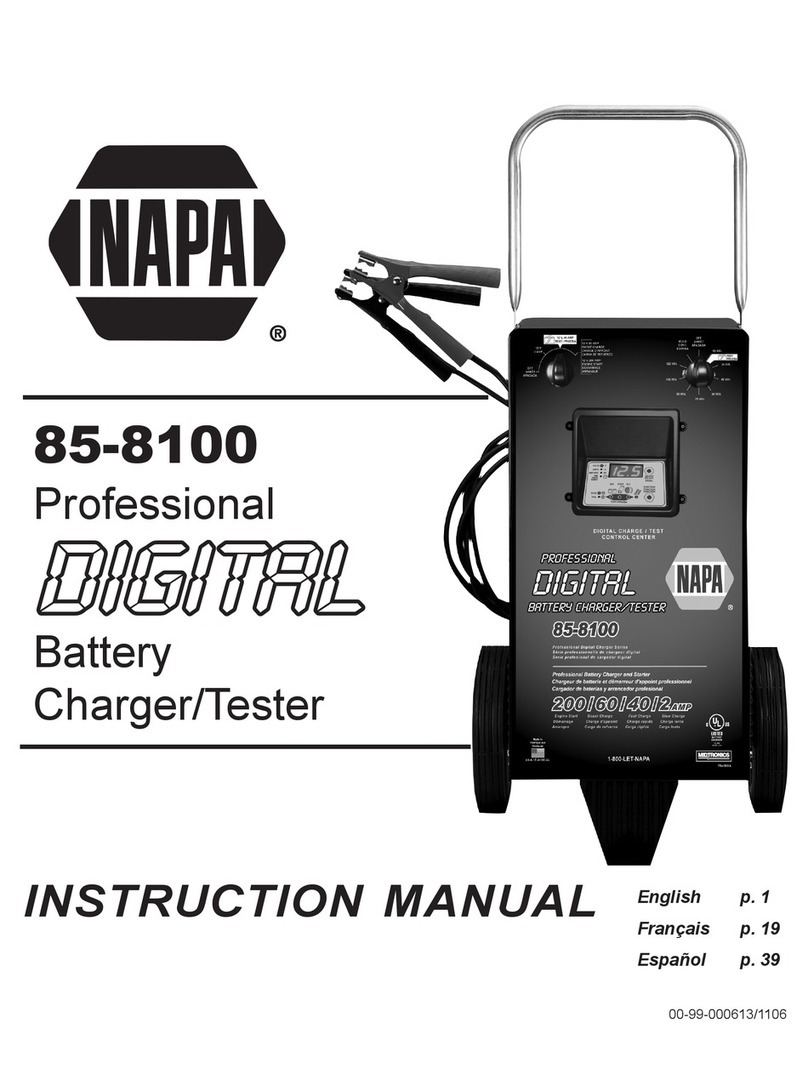Napa 85-2500 User manual

6/12 V
200/50/30 /10 A
Motive Power
Model 85-2500
Professional Battery
Charger and Starter
INSTRUCTION MANUAL
English ................................................. p. 1
Français ................................................. p. 15
Español ................................................. p. 31
00-99-000214/1006


1. IMPORTANT SAFETY INSTRUCTIONS
WARNING—RISK OF EXPLOSIVE GASES
1.1 WORKING IN THE VICINITY OF A LEAD-ACID BATTERY IS
DANGEROUS. BATTERIES GENERATE EXPLOSIVE GASES DURING
NORMAL BATTERY OPERATION, AND WHEN DISCHARGED OR
CHARGED. FOR THIS REASON, IT IS OF UTMOST IMPORTANCE
THAT BEFORE USING YOUR CHARGER, YOU READ THIS MANUAL
AND FOLLOW THE SAFETY AND OPERATING INSTRUCTIONS
EXACTLY.
1.2 To reduce risk of battery explosion, follow these safety instructions and
those published by the battery manufacturer and the manufacturer of any
equipment you intend to use in the vicinity of a battery. Review cautionary
markings on these products and on engine, and on vehicle or equipment
containing the battery.
1.3 CAUTION: TO REDUCE THE RISK OF INJURY, CHARGE ONLY
RECHARGEABLE LEAD-ACID-TYPE BATTERIES WHICH MAY
INCLUDE MAINTENANCE-FREE, LOW-MAINTENANCE OR DEEP
CYCLE BATTERIES. OTHER TYPES OF BATTERIES MAY BURST
CAUSING PERSONAL INJURY AND DAMAGE.
If you are uncertain as to the type of battery you are attempting to charge,
or the correct procedure for checking the battery’s state of charge, contact
the seller or battery manufacturer.
1.4 Use of an attachment not recommended or sold by the battery charger
manufacturer may result in a risk of re, electric shock, or injury to persons.
1.5 To reduce risk of damage to the electric plug and cord, pull by the plug
rather than the cord when disconnecting the charger.
1.6 Position the AC and DC leads to avoid tripping over them and to prevent
damage by the vehicle hood, doors, or moving engine parts; protect the
leads from heat, oil, and sharp edges.
1.7 Do not operate the charger if it has received a sharp blow, been dropped,
or otherwise damaged in any way; take it to a qualied service center.
1.8 Do not disassemble the charger; take it to a qualied service center when
repair is required. Incorrect reassembly may result in a risk of electric
shock or re.
•1 •
IMPORTANT: READ AND SAVE THIS SAFETY AND INSTRUCTION MANUAL.
KEEP IT WITH OR NEAR THE CHARGER AT ALL TIMES.
CAUTION: THE CHARGER MUST BE FULLY ASSEMBLED BEFORE
OPERATING. SEE SECTION 13 FOR INSTRUCTIONS.

1.9 To reduce risk of electric shock, unplug the charger from the AC outlet
before attempting any maintenance or cleaning. Turning off the controls will
not reduce this risk.
1.10 Boat batteries must be removed and charged on shore. To safely
charge them onboard requires equipment especially designed and UL
Listed for marine use.
1.11 Connect and disconnect the battery leads only when the AC supply cord is
disconnected.
1.12 Do not overcharge the battery. (See sections 3, 10, and 11.)
1.13 When charging a battery, charge it in a dry, well-ventilated area.
1.14 Never place articles on or around the charger. Never locate the charger in
a way that will restrict the ow of cooling air through the cabinet.
1.15 An extension cord should not be used unless absolutely necessary. (See
paragraph 4.3.)
1.16 WARNING: THIS EQUIPMENT EMPLOYS PARTS, SUCH AS SWITCHES
AND CIRCUIT BREAKERS, THAT CAN PRODUCE ARCS OR SPARKS.
LOCATE THE CHARGER AT LEAST 46 CM (18 INCHES) ABOVE
GROUND LEVEL. IF USED IN A GARAGE, LOCATE IN A ROOM OR
ENCLOSURE PROVIDED FOR THE PURPOSE, AND NOT LESS THAN
46 CM (18 INCHES) ABOVE FLOOR LEVEL.
1.17 WARNING: Handling the cord on this product or cords associated with
accessories sold with this product, may expose you to lead, a chemical
known to the State of California to cause cancer and birth defects or other
reproductive harm. Wash hands after handling.
1.18 Have a damaged cord or plug replaced immediately.
1.19 Do not expose the charger to rain or snow.
2. PERSONAL PRECAUTIONS
2.1 Always have someone within range of your voice or close enough to come
to your aid, when working around lead-acid batteries.
2.2 Have plenty of fresh water and soap nearby in case battery acid contacts
skin, clothing, or eyes.
2.3 Wear complete eye protection, clothing protection, and rubber soled shoes.
Place a damp cloth over the battery to protect against acid spray. When
the ground is very wet or covered with snow, wear rubber boots. Avoid
touching eyes while working near the battery.
2.4 If battery acid contacts skin or clothing, wash immediately with soap and
water. If acid enters the eyes, immediately ush with running cold water for
at least 10 minutes and seek medical attention.
2.5 NEVER smoke or allow a spark or ame in vicinity of the battery or engine.
2.6 Be extra cautious to reduce risk of dropping a metal tool onto the battery.
It might spark or short circuit the battery or other electrical part that may
cause an explosion.
•2 •

2.7 Before working with a lead acid battery, remove personal metal items
such as rings, bracelets, necklaces, watches, etc. A lead acid battery can
produce a short circuit current high enough to weld such items, causing a
severe burn.
2.8 CAUTION: TO REDUCE THE RISK OF INJURY, CHARGE ONLY
RECHARGEABLE LEAD ACID TYPE BATTERIES WHICH MAY
INCLUDE MAINTENANCE FREE, LOW MAINTENANCE, OR DEEP
CYCLE BATTERIES. OTHER TYPES OF BATTERIES MAY BURST
CAUSING PERSONAL INJURY AND DAMAGE.
The charger is not intended to supply power to a low-voltage electrical
system other than applications using rechargeable, lead-acid type
batteries. Do not use the battery charger to charge dry-cell batteries used
with home appliances. These batteries may burst and cause personal
injury or property damage.
2.9 NEVER charge a frozen battery. Thaw it out rst. Charging will then be
safer and more efcient.
3. PREPARING TO CHARGE BATTERY
3.1 If necessary to remove the battery from the vehicle to charge, always
remove the grounded terminal from battery rst. Make sure all accessories
in the vehicle are off to prevent a possible arc.
3.2 Be sure the area around the battery is well ventilated while the battery
is being charged. Gas can be forcefully blown away by using a piece of
cardboard or other nonmetallic material as a fan.
3.3 Clean the battery terminals. Be careful to keep corrosion from coming into
contact with your eyes.
3.4 Add distilled water in each cell until the battery electrolyte reaches the
level specied by manufacturer. This helps purge excessive gas from
cells. Do not overll. For a battery without caps, carefully follow the
manufacturer’s recharging instructions.
3.5 Study all battery manufacturer’s specic precautions, such as removing or
not removing cell caps while charging, and recommended rates of charge.
3.6 Determine voltage of the battery by referring to the vehicle owner’s
manual, and make sure that the output voltage selector switch is set at the
correct voltage. If the charger has an adjustable charge rate, charge the
battery initially at lowest rate. If the charger has only one voltage, verify
that the battery voltage matches the voltage of charger. For a charger
not having an output voltage selector switch, determine the voltage of
the battery by referring to the vehicle owner’s manual and make sure it
matches the output rating of the battery charger.
•3 •

4. AC POWER CORD CONNECTION INSTRUCTIONS
4.1 The charger must be grounded to reduce the risk of electric shock. The
charger is equipped with an electric cord having an equipment grounding
conductor and a grounding plug. The plug must be plugged into an outlet
that is properly installed and grounded in accordance with all local codes
and ordinances.
DANGER: NEVER ALTER CHARGER’S ORIGINAL AC CORD OR
PLUG. IF THE PLUG DOES NOT FIT OUTLET, HAVE PROPER
OUTLET INSTALLED BY A QUALIFIED ELECTRICIAN. IMPROPER
CONNECTION CAN RESULT IN THE RISK OF AN ELECTRIC SHOCK.
DISCONNECT THE PLUG FROM OUTLET WHEN CHARGER IS IDLE.
4.2 This battery charger is for use on a nominal 120-volt circuit and has a
grounding plug that looks like the plug illustrated in Figure A. A temporary
adapter, which looks like the adapter illustrated in Figures B and C, may be
used to connect this plug to a two-pole receptacle as shown in Figure B, if
a properly grounded outlet is not available. The temporary adapter should
be used only until properly grounded outlet can be installed by a qualied
electrician.
DANGER: BEFORE USING AN ADAPTER AS ILLUSTRATED, BE
CERTAIN THAT THE CENTER SCREW OF THE OUTLET PLATE
IS GROUNDED. THE GREEN-COLORED RIGID EAR OR LUG
EXTENDING FROM ADAPTER MUST BE CONNECTED TO A
PROPERLY GROUNDED OUTLET. MAKE CERTAIN IT IS GROUNDED.
IF NECESSARY, REPLACE THE ORIGINAL OUTLET COVER PLATE
SCREW WITH A LONGER SCREW THAT WILL SECURE THE
ADAPTER EAR OR LUG TO THE COVER PLATE AND MAKE THE
GROUND CONNECTION TO THE GROUNDED OUTLET.
•4 •

4.3 An extension cord should not be used unless absolutely necessary. Use of
an improper extension cord could result in a risk of re and electric shock.
If an extension cord must be used, make sure:
a. That the pins on the plug of extension cord are the same number, size,
and shape as those of the plug on charger;
b. That the extension cord is properly wired and in good electrical
condition;
c. That the wire size is large enough for AC ampere rating of the charger
as specied in the following table.
5. CHARGER LOCATION
5.1 Locate the charger as far away from the battery as the charger cables
permit.
5.2 Never place the charger directly above the battery being charged; gases
from the battery will corrode and damage charger.
5.3 Never allow the electrolyte to drip on the charger when taking gravity
readings or lling a battery.
5.4 Operate the charger only in well ventilated area, free of dangerous vapors.
5.5 Store the charger in a safe, dry location and maintain it in perfect condition.
5.6 Do not set the battery on top of charger or where acid might drip onto
charger.
•5 •

6. DC CONNECTION PRECAUTIONS
6.1 All switches should be set in OFF (O) position and the AC cord should be
disconnected from the electrical outlet before you connect and disconnect
the charger clamps. Never allow the clamps to touch each other.
6.2 When attaching the charger clamps, be certain to make the best possible
mechanical as well as electrical connection. This will tend to prevent the
clamps from slipping off connections, avoid dangerous sparking, and as-
sure safer and more efcient charging. Keep the clamps clean.
CAUTION: SETTING SWITCHES TO OFF (O) DOES NOT ALWAYS
DISCONNECT THE CHARGER ELECTRICAL CIRCUIT FROM THE AC
POWER CORD OR DC CHARGER CLAMPS.
7. BATTERY IN VEHICLE OR CONNECTION TO ENGINE
7.1 Before working on the vehicle, rmly apply the emergency brake and place
the gearshift to NEUTRAL. Shift an automatic transmission to PARK.
7.2 Locate the charger as far away from the battery as the charger cords per-
mit, and position the AC and DC cords to avoid stepping on or tripping over
them and to prevent damage by hood, doors, or moving engine parts.
7.3 Stay clear of fan blades, belts, pulleys, and any other parts that can cause
physical injury.
7.4 Turn OFF all vehicle loads, including door lights, and correct any defects in
vehicle’s electrical system that may have caused low battery.
7.5 Check the polarity of battery posts. The POSITIVE (POS., P, +) post usu-
ally has larger diameter than NEGATIVE (NEG., N,–) post.
7.6 Determine which post of the battery is grounded (connected) to the chas-
sis. If the negative post is grounded (as in most vehicles), see paragraph
7.7. If the positive post is grounded, see paragraph 7.8.
7.7 For a negative-grounded vehicle, rst connect the POSITIVE (red) clamp
from the charger to the POSITIVE (POS., P, +) ungrounded post of battery.
Then connect the NEGATIVE (BLACK) clamp to vehicle chassis or engine
block away from battery. Do not connect the clamp to the carburetor, fuel
lines, or sheet-metal body parts. Connect to a heavy-gauge metal part of
the frame or engine block. When disconnecting the charger, turn the switch
to OFF (O), disconnect the AC cord, remove the clamp from the vehicle
chassis, and then remove the clamp from the battery terminal.
7.8 For a positive-grounded vehicle, connect the NEGATIVE (BLACK) clamp
from the charger to the NEGATIVE (NEG., N, –) ungrounded post of the
battery. Then connect the POSITIVE (RED) clamp to the vehicle chassis
or engine block away from the battery. Do not connect the clamp to the
carburetor, fuel lines, or sheet-metal body parts. Connect to a heavy-gauge
metal part of the frame or engine block.
•6 •

When disconnecting the charger, turn the switch to OFF (O), disconnect
the AC cord, remove the clamp from the vehicle chassis, and then remove
the clamp from the battery terminal.
CAUTION: WHEN THE POSITIVE (+) POST OF THE VEHICLE
BATTERY IS GROUNDED, DOUBLE-CHECK POLARITY.
8. THE BATTERY OUTSIDE THE VEHICLE OR EQUIPMENT—NOT
CONNECTED TO THE ENGINE
If necessary to remove the battery from the vehicle or equipment, always
remove the grounded terminal from the battery rst.
WARNING: MAKE SURE ALL VEHICLE LOADS ARE OFF TO
PREVENT A POSSIBLE ARC.
FOLLOW THESE STEPS WHEN THE BATTERY IS OUTSIDE THE
VEHICLE. A SPARK NEAR BATTERY MAY CAUSE AN EXPLOSION. TO
REDUCE RISK:
8.1 Check the polarity of the battery posts. The POSITIVE (POS., P, +) post
usually has a larger diameter than the NEGATIVE (NEG., N, –) post.
8.2 Attach an insulated battery cable that is at least a 24-inch, 6-gauge to the
NEGATIVE (NEG., N, –) battery post.
8.3 Connect the POSITIVE (RED) charger clamp to the POSITIVE (POS.,
P, +) post of the battery.
8.4 Position yourself and the free end of cable as far away from the battery as
possible. Do not face the battery when making the nal connection. Then
connect the NEGATIVE (BLACK) charger clamp to the free end of the
cable.
8.5 When disconnecting the charger, always do so in the reverse sequence of
the connecting procedure. Break the rst connection while staying as far
away from the battery as practical.
9. CHARGER FEATURES AND CONTROLS
9.1 ON/OFF SWITCH
The ON (I) /OFF (O) switch is located in the upper left-hand corner. The
OFF (O) position disconnects the AC input current to the charger, but it
does not disconnect the output of the charger from the battery.
9.2 AMMETER
Supplied on front of charger, it indicates amount of amps owing from
charger into battery. The meter’s front has zones marked CHARGE,
START, and a graphed numerical value.
•7 •

9.3 RATE/VOLTAGE SELECTOR SWITCH
The charger has a RATE/VOLTAGE selector switch, located at the top
center of the charger which controls the voltage and current. Ensure
that the voltage setting selected matches the voltage of the battery
intended for charging. Select the amp rate that suits your application as
described below:
10 AMP: For slow-charging low-rated batteries used in motorcycles, snow
mobiles, lawn and garden tractors, etc. Trickle charging automotive size
batteries.
30 AMP: For fast charging automotive-style, regular and deep-cycle
batteries. DO NOT use on small, low capacity batteries.
50 AMP BOOST CHARGE: For momentary high rate output. Refer to
charger front panel for time duration.
100–200 AMP: For automotive, engine-assisted cranking-starting only.
Refer to section 9.4.
WARNING: AT HIGHER AMP RATES, IT BECOMES EASIER TO BOIL
AND OVERCHARGE THE BATTERY. DO NOT LEAVE THE CHARGER
UNATTENDED. REFER TO THE BATTERY MANUFACTURER’S
CHARGING INSTRUCTIONS. USE THE CHARGING TIME CHART IN
SECTION 11 TO DETERMINE HOW LONG TO CHARGE.
9.4 ENGINE START
The charger’s capacity to provide a high current is suitable for starting
a vehicle that will not start due to a depleted battery. With the RATE/
VOLTAGE selector switch set to 30 AMP, charge the battery for 5 minutes.
After 5 minutes of charge, select the ENGINE START position and engage
the vehicle starter.
If the vehicle does not start after 3 to 5 seconds, release the starter, return
the charger to the 30 AMP position, and wait for another 5 minutes. If the
engine fails to start after a second or third attempt, disconnect the charger.
Before replacing the battery, use a battery tester to test it.
DO NOT attempt to start a vehicle without the battery properly installed.
Damage may result to the vehicle’s electrical system.
•8 •

9.5 OVERLOAD PROTECTION
The charger uses an output circuit breaker and a thermal breaker to
prevent overheating and damage to the charger and the vehicle. If after
repeated starting attempts, the charger does not indicate any output on its
meter, it may be because one of the two breakers has opened. If the output
breaker opens due to excessive current, a popping noise will be heard. It
will automatically reset itself in a couple of minutes. If the thermal breaker
opens, it will automatically reset itself in about 15 to 30 minutes.
10. ELECTRICAL CONDITION OF BATTERY
10.1 The state of charge of rellable-top batteries can be checked by using a
hydrometer. A hydrometer is a bulb-type syringe which is used to extract
a small quantity of the electrolyte from each battery cell. A oat in the
hydrometer barrel indicates the specic gravity of the electrolyte. This
specic gravity reading indicates the battery’s state of charge at a given
temperature, as shown in the table below:
•9 •
**Initial specic gravity readings vary, depending on battery type and
manufacturer. Contact the seller or manufacturer of the battery for this
specication.
10.2 The state of charge of sealed-top (maintenance-free and recombination-
type) batteries must be checked with a high resolution voltage tester.
10.3 If uncertain about type of battery you will be charging, or the correct
procedure for checking the battery’s state of charge, contact the seller or
manufacturer of the battery.
10.4 The temperature of the battery and the equipment the battery is used
with has a dramatic effect on battery efciency and system power
requirements. For example, at –18 oC (0 oF) , a battery is operating at 40%
of its rated efciency, while the engine it is attempting to start requires over
twice as much power as would be necessary at 27 oC (80 o F).

11. BATTERY CHARGING
11.1 Determine battery’s state of charge by following the instructions and chart
in section 10. Connect charger as per instructions in sections 7 and/or 8.
11.2 From the chart below, pick the row closest to the battery’s sate of charge
and read across to the battery size being charged. This value indicates the
approximate time required to recharge the battery.
•10 •
11.3 An alternative method for calculating the time required to recharge a
battery in good condition is to follow this formula:
(reserve capacity in minutes) + 15.5 = amp hour capacity
2
(amp hour capacity) x (percent of charge needed) = time in hours
charger amp rate setting
(time in hours) x (recharge factor of 1.25) = recharge time
Example: Suppose a battery has an RC of 120 minutes and is
discharged down to 25%. We need to put in 75% more charge and we
want to use our charger’s 30 AMP charge setting:

120 minutes + 15.5 = 75.5 amp hours
2
(75.5 amp hours) x (0.75) = time = 1.9 hours
30-amp charge rate
Then:
(1.9 hours) x (recharge factor of 1.25) = 2.38 hours or 142 minutes
recharge time.
12. MULTIPLE BATTERY CHARGING
Batteries of the voltage may be connected in parallel for maintenance
charging. Charge time increases in proportion to the number of batteries.
Rate of charge decreases in the same proportion.
Example: Charging 2 batteries in parallel will take 2 times longer; each
battery receives 1/2 the amount of charge showing on the ammeter. Thus,
if the ammeter shows a 30-amp charge, each battery will get a 15-amp
charge (when batteries have the same rating, same state of charge, etc.).
•11 •
13. ASSEMBLY INSTRUCTIONS
CAUTION: The charger must be fully assembled before operating.
Refer to the illustration on the next page:
1. Attach handle to the unit with screws provided. Refer to drawing.
2. Remove backing and attach the four rubber feet on the bottom.

14. MAINTENANCE INSTRUCTIONS
The charger is designed and built with high quality materials requiring only
a minimum amount of care.
14.1 Clamps should be cleaned each time the charger is used to prevent
corrosion from battery uid.
14.2 Cords should be coiled when the charger is not being used to prevent
damage.
14.3 Other servicing should be performed by qualied service personnel.
15. TROUBLESHOOTING
15.1 No meter reading while charging:
a. Check AC outlet to be sure it is live.
b. Check connections to battery.
c. A circuit breaker may have opened. Refer to section 9.5.
d. Ensure that all operating instructions were followed.
15.2 High meter readings while charging:
a. Ensure that battery connections are not reversed.
b. High meter readings can also be caused by a battery with one or
more dead cells.
15.3 Certain battery conditions can cause meter to indicate incorrectly including
cold, sulphated, or damaged batteries.
•12 •

16. LIMITED WARRANTY
SCHUMACHER ELECTRIC CORPORATION, 801 BUSINESS CENTER
DRIVE, MOUNT PROSPECT, ILLINOIS, 60056-2179 MAKES THIS
LIMITED WARRANTY TO THE ORIGINAL PURCHASER AT RETAIL OF
THIS PRODUCT. THIS LIMITED WARRANTY IS NOT TRANSFERABLE.
Schumacher Electric Corporation warrants this battery charger against
defective material or workmanship. If such should occur, the unit will be
repaired or replaced at the option of the manufacturer. It is the obligation
of the purchaser to forward the unit together with proof of purchase,
transportation and / or mailing charges prepaid to the manufacturer or its
authorized representative. This limited warranty is void if the product is
misused, subjected to careless handling, or repaired by anyone other than
the factory or other authorized factory representative. The manufacturer
makes no warranty other than this limited warranty and expressly excludes
any implied warranty including any warranty for consequential damages.
This is the only express limited warranty and the manufacturer neither
assumes nor authorizes anyone to assume or make any other obligation
towards the product other than this express limited warranty. The
manufacturer makes no warranty of merchantability or tness for purpose
of this product and expressly excludes such from this limited warranty.
Some states do not allow the exclusion or limitation of incidental or
consequential damages or length of implied warranty so the above
limitations or exclusions may not apply to you. “This warranty gives you
specic legal rights, and you may have other rights which vary from state
to state.”
17. CUSTOMER SERVICE
For customer service (Monday through Friday), call:
1-888-263-4906, 7 a.m. to 4:30 p.m. (Central Time)
•13 •
Send Warranty Product Repairs to:
Schumacher Electric Corporation, Warranty Service Department
1025 East Thompson, Hoopeston, IL 60942-0280
Phone: 1-888-263-4906 (Hours: 7 a.m. – 4:30 p.m. CST)
DSR Professional Products
801 Business Center Drive, Mount Prospect, IL 60056-2179

•14 •

Modèle 85-2500
Chargeur de batterie
et démarreur d’appoint
professionnel
6/12 V
200/50/30 /10 A
Materiél moteur
MANUEL D’INSTRUCTIONS
•15 •

•16 •

IMPORTANT : LISEZ ATTENTIVEMENT CE MODE D’EMPLOI. GARDEZ-LE
TOUJOURS À PROXIMITÉ DU CHARGEUR.
MISE EN GARDE : LE CHARGEUR DOIT ÊTRE COMPLÈTEMENT
ASSEMBLÉ AVANT SON UTILISATION. CONSULTEZ LA SECTION 13.
1. MISES EN GARDE ET CONSIGNES DE SÉCURITÉ—GAZ EXPLOSIFS
1.1 IL EST DANGEREUX DE TRAVAILLER À PROXIMITÉ D’UNE BATTERIE
AU PLOMB. LES BATTERIES PRODUISENT DES GAZ EXPLOSIFS
DURANT LEUR FONCTIONNEMENT NORMAL ET LORS DE LEUR
CHARGE OU DE LEUR DÉCHARGE. C’EST POURQUOI VOUS DEVEZ
LIRE ATTENTIVEMENT CE MODE D’EMPLOI AVANT D’EMPLOYER
VOTRE CHARGEUR ET SUIVRE SCRUPULEUSEMENT LES
CONSIGNES DE SÉCURITÉ ET D’UTILISATION QUI Y FIGURENT.
1.2 An de réduire les risques d’explosion, respectez les consignes de
sécurité qui gurent dans ce mode d’emploi et dans les modes d’emploi
des appareils que vous comptez utiliser à proximité de la batterie. Lisez
attentivement toutes les étiquettes apposées sur les appareils, sur le
moteur et sur le véhicule ou le dispositif qui contient la batterie.
1.3 MISE EN GARDE : AFIN DE RÉDUIRE LES RISQUES DE
BLESSURE, CHARGEZ UNIQUEMENT LES BATTERIES AU PLOMB
RECHARGEABLES, Y COMPRIS LES BATTERIES SANS ENTRETIEN,
À FAIBLE ENTRETIEN ET À CYCLE PROFOND. LES AUTRES
TYPES DE BATTERIE RISQUENT D’EXPLOSER ET DE CAUSER DES
BLESSURES GRAVES ET DES DOMMAGES MATÉRIELS.
Si vous ne connaissez pas le type de la batterie que vous vous apprêtez à
recharger ou si vous ne savez pas comment vérier l’état de charge de la
batterie, communiquez avec le vendeur ou le fabricant de la batterie.
1.4 L’utilisation d’une pièce d’équipement non recommandée par le fabricant
du chargeur de batterie peut entraîner des risques d’incendie, de choc
électrique ou de blessure.
1.5 Pour éviter d’endommager le câble d’alimentation, tirez sur la che et non
sur le cordon lorsque vous débranchez le chargeur.
1.6 Placez les câbles c.a. et c.c. à l’abri des passages fréquents et loin des
pièces mobiles du moteur et du véhicule (capot, portières, etc.). Protégez-
les de la chaleur, de l’huile et des rebords tranchants.
1.7 Ne faites pas fonctionner le chargeur s’il a reçu un coup violent, s’il est
tombé ou s’il est endommagé de quelque façon que ce soit. Conez-le à
un centre de réparation qualié.
1.8 Ne démontez pas le chargeur vous-même. S’il doit être réparé, conez-le
à un centre de réparation qualié. Un chargeur mal remonté peut entraîner
des risques d’incendie et de choc électrique.
1.9 An de réduire les risques de choc électrique, débranchez le chargeur de
la prise d’alimentation c.a. avant son entretien ou son nettoyage. Mettre les
commandes à la position d’arrêt ne suft pas à réduire ces risques.
•17 •

1.10 LES BATTERIES DE BATEAU DOIVENT ÊTRE RETIRÉES DE
L’EMBARCATION ET CHARGÉES SUR LA TERRE FERME. LA
CHARGE DES BATTERIES À BORD EXIGE DES APPAREILS
SPÉCIAUX HOMOLOGUÉS UL POUR L’UTILISATION MARINE.
1.11 Débranchez toujours le câble d’alimentation c.a. du chargeur avant de
brancher ou de débrancher les câbles de batterie.
1.12 Ne surchargez jamais la batterie. (Voir les sections 3, 10 et 11.)
1.13 Chargez la batterie dans un endroit sec et bien ventilé.
1.14 Ne déposez pas d’objets sur le chargeur ou à proximité. Installez le
chargeur dans un endroit où l’air frais circule aisément tout autour du
boîtier.
1.15 L’utilisation d’une rallonge électrique n’est pas recommandée, à moins de
nécessité absolue. (Voir la section 4.3.)
1.16 MISE EN GARDE : CET ÉQUIPMENT UTILISE DES PIÈCES,
COMME DES INTERRUPTEURS ET DES DISJONCTEURS, QUI ONT
TENDANCE À PRODUIRE DES ARCS OU DES ÉTINCELLES. PLACEZ-
LE À AU MOINS 46 CM (18 POUCES) AU-DESSUS DU SOL. EN CAS
D’UTILISATION DANS UN GARAGE, PLACEZ L’EQUIPMENT DANS
UNE PIÈCE OU UNE ENCEINTE FOURNIE À CETTE FIN ET À AU
MOINS 46 CM (18 POUCES) AU-DESSUS DU SOL.
1.17 MISE EN GARDE : La manipulation du cordon de cet appareil ou du
cordon des accessoires vendus avec ce produit peut entraîner une
exposition au plomb, un produit chimique reconnu par l’État de la Californie
pour causer le cancer ainsi que des anomalies congénitales ou autre
dommage génétique. Lavez soigneusement vos mains après toute
manipulation.
1.18 Remplacez sans attendre tout câble, che ou cordon endommagé.
1.19 N’exposez pas le chargeur à la pluie ou à la neige.
2. PRÉCAUTIONS PERSONNELLES
2.1 Lorsque vous travaillez à proximité d’une batterie au plomb, restez toujours
à portée de voix d’une autre personne ou assez près pour que cette
personne puisse vous porter secours rapidement.
2.2 Gardez toujours une bonne réserve d’eau fraîche et du savon à proximité,
au cas où l’acide de la batterie entrerait en contact avec votre peau, vos
yeux ou vos vêtements.
2.3 Portez un dispositif de protection des yeux, des vêtements de protection
et des chaussures isolées à semelle de caoutchouc. Déposez un linge
humide sur la batterie pour vous protéger des projections d’acide. Si le sol
est détrempé ou couvert de neige, portez des bottes de caoutchouc. Évitez
de porter les mains à vos yeux lorsque vous travaillez à proximité d’une
batterie.
•18 •
Other manuals for 85-2500
1
Table of contents
Languages:
Other Napa Batteries Charger manuals
